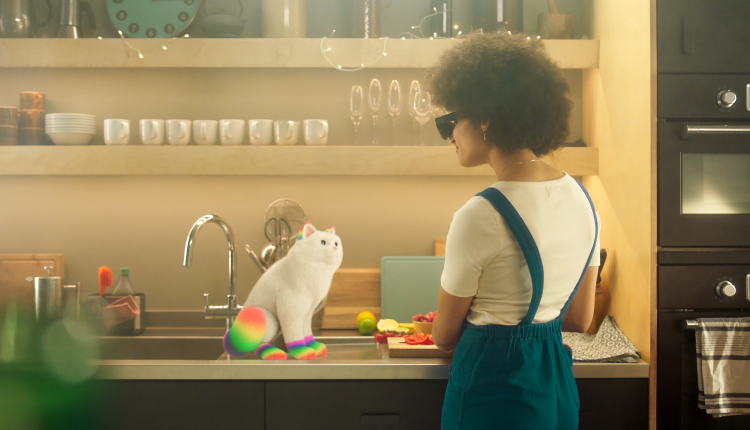Tiny Rebel’s CEO Susan Cummings on why web3 games should be more fun

While the team is gearing up for its upcoming alpha launch of Petaverse later in 2023, Tiny Rebel Games’ CEO Susan Cummings spent some time talking to us over email about the inspiration behind its mobile-based pet game.
With an obvious passion for new technology and engaging games, Cummings discusses the value of data ownership, and shares her view on what the web3 games audience is getting wrong. She emphasises why the industry needs to move away from blockchain terminology and make engaging experiences a priority.
BlockchainGamer.biz: Can you start off by giving us some background to Tiny Rebel Games?

Cummings: We started life as a US company 15 years ago after leaving 2K Games/Rockstar Games. Then, when my partner and I moved to the UK in 2016, we set up our UK company. So in effect, we’ve been around a very long time.
We love being on the edge of new technology trends; finding meaningful use cases in new technologies, working out how to turn them into fun and engaging user-oriented experiences. Once upon a time, that was mobile gaming (we created the award-winning Doctor Who: Legacy and Doctor Who Infinity games). Then we migrated into the mobile AR space, winning the bid for a multi-million pound grant from the British government collaborating with our good friends at Aardman to create Wallace & Gromit: The Big Fix Up and Fix Up the City. These bleeding edge R&D experiments in augmented reality were both shortlisted for, or won, multiple international awards including Cannes Lions and Fast Company.
Petaverse is a natural evolution of everything we’ve learned over the years. A new phase of our company kicked off when we closed our seed round of funding back at the start of 2022 and we have now grown to 24 people across the UK and Europe.
What sparked the passion to make a game revolving around pets?
Pets are a global connector – they transcend geography, economics, religion, gender – we all understand the joy and companionship to be had with a cat or a dog, or a bird or a horse, in fact any animal we forge an emotional bond with. So they’re also an ideal way to onboard users to new technology – it makes the tech less abstract, less frightening, more relatable. And it’s evergreen – beginning with Tamagotchi in the 90s, every 10 years or so there has been a big inflection – Tamagotchi was followed a decade later by Nintendogs.
A decade later, games like Adopt Me! and Pet Simulator exploded on Roblox. We’re due for a new digital pet – and in this case, we can evolve with two big innovations: autonomy (AI can give your pet an independent, trackable life) and interoperability (the ability to take your companion across your digital life, wherever you want to go).
Why did you initially choose to adopt blockchain technology, and has your view on how this can enhance gaming experiences changed over time?
Over the years, millions of people have played digital pet games – over 80 million played with a Tamagotchi, 26 million with Nintendogs, over 30 million with Neopets, and so on. But these pets weren’t really ours – we were renting them until the game was shut down. There have even been petitions over the years by frustrated users, after devoting so much time and attention to them, naturally wanting their digital pet back!
We believe that freedom of data is fundamentally important and the option to own and control your own data will become increasingly important to consumers.
What other lessons have you learnt along the way?
We have learned countless lessons over the last couple of years. The web3 audience – insofar as there still is one – is largely apathetic about utility. They claim they want utility from the NFT projects they hold but largely they just want to know when the price will go up. That’s not what the game industry is about nor should it be. So I think it’s a mistake to try to play that game of floor price, FOMO, and quick ‘mint out’ strategies.
Web3’s use case is as a database – that doesn’t need to be any scarier than Google Cloud or Amazon Web Services. But it is scary because of the connotations. The reality is it’s a better database where the consumer can be empowered. But we need to educate users to get there – and the best way to do this is to distance ourselves from the baggage associated with the “NFT”.
What significant difference have you noticed between web2 and web3 gamers?
Personally, I think it’s a mistake to separate them … gaming is about engaging, interactive and fun entertainment – whether or not it uses web3 shouldn’t be the point and I think that’s largely what has kept so many traditional gamers away, this focus on the database.
I guess the distinction right now is that those who are gaming in web3 are already comfortable with blockchain and likely came from the crypto world. That’s a much smaller audience of course than is in web2 and the key now is to broaden reach.
We need to completely destroy the old vocabulary of web3 and return to fun and engaging entertainment as the primary focus.
Susan Cummings, Tiny Rebel Games
Who is your target audience, and has this changed since the initiation of Petaverse?
The mass market – the same people who have played every other virtual pet game over the years. 8 to 80 years old you might say. Our goal was always to get to them but we thought we needed to start with the core NFT user. We actually think there’s a massive opportunity to onboard a broader audience and gently lead them into comfort with the blockchain when and if they decide to protect and control their data.
Did you always plan to launch the game on mobile, and what are your future distribution plans?
Mobile has always been a core part of Petaverse. In fact, we already have the Petaverse meme-o-tron live on the App Store and Google Play. We also support browser, as will the forthcoming game…
The core game of Petaverse, which will soft launch in a couple of months, is a traditional virtual pet game in the sense that you come in, find out what your pet has been up to (via ChatGPT integration and a diary system – these cats have a life of their own, like real ones), find out what they need, play simple to pick up/difficult to master mini games which star your pet, work your way up the leaderboards, unlock gear for your pet and their space.
However, this isn’t just about a game — you’ll also be able to bring your pet into VR (we have a live integration in private beta on the Quest 2), onto your Twitch/YouTube stream, onto your video calls, into a text based storytelling adventure, or into AR in the meme-o-tron. We’ll be adding more use cases as we roll out and even letting other teams build on our tech stack.
What needs to change for web3 games to become mainstream?
They need to stop being ‘web3 games’ – they need to be games which embrace various technologies when they make sense for the user (be it web3, AI, AR, VR, etc).
We need to avoid scary terms like NFT. When we talk about the Internet, we don’t talk about TCPIP, HTML, etc – we talk about being online, about having fun, about being social. We need to completely destroy the old vocabulary of web3 and return to fun and engaging entertainment as the primary focus.
2023 has proven to be a more difficult year for blockchain gaming than many anticipated. How bullish are you for the near future of the industry?
I am very bullish on games which aren’t rushing web3 and are focusing on building compelling experiences first and foremost.
With many of the early blockchain games recently crossing their 5 year mark, where do you see web3 gaming in the next 5 years?
I see games successfully and carefully incorporating blockchain where it’s relevant, appropriate and desired by their community.
Petaverse’s alpha will launch on Google Play and Apple App Store in October 2023 . For more details, visit the Petaverse website.
